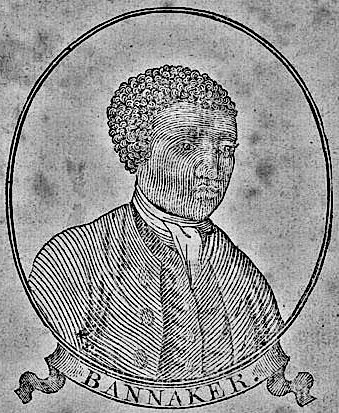
Benjamin Banneker (1731 – 1806) woodcut
On November 9, 1731, American almanac author, surveyor, naturalist and farmer Benjamin Banneker was born. Born in Baltimore County, Maryland, to a free African American woman and a former slave, Banneker had little formal education and was largely self-taught. Banneker’s knowledge of astronomy helped him author a commercially successful series of almanacs. He corresponded with Thomas Jefferson, drafter of the United States Declaration of Independence, on the topics of slavery and racial equality. Abolitionists and advocates of racial equality promoted and praised his works.
„Never abandon your vision. Keep reaching to further your dreams.“
– Benjamin Benneker
Benjamin Banneker – Early Years
Banneker was born a free citizen under the name Benjamin Bannaky, as his parents (his mother by birth, his father had ransomed himself) were also free. His grandmother, a native of England, was sentenced to hard labor as a bonded laborer in Maryland for alleged theft. After her seven-year labor contract expired, she bought a tobacco farm and later married one of her two slaves, an African. Banneker grew up on this farm and attended a Quaker school for several winters, but his knowledge and skills came primarily from his grandmother, much of which he also taught himself. He showed an early aptitude for mathematics and mechanics.
A Pocket Watch
In 1753, at age 22 Banneker developed one of the first pocket watches made entirely of U.S. material from wood, which made him well-known in the region. The clock not only worked for the rest of Banneker’s life but also increased Benjamin Banneker’s reputation in the community. In 1759, Banneker’s father died and he continued to live with his mother and sisters. In 1772, the Ellicott family moved into the area and Banneker became friends with George Ellicott due to their shared interest in science. Ellicott loaned Banneker books and equipment to begin a more formal study of astronomy around 1788.
Astronomy
During the end of the 1780s, Banneker sent George his work calculating a solar eclipse. In the 1790s, the surveyor Major Andrew Ellicott (cousin of George Ellicott) hired Benjamin Banneker to assist in a survey project to place boundary stones at or near every mile point along the borders of the (new) capital territory. Banneker’s contributions included astronomical observations as well as maintaining a clock to relate points on the ground to the positions of stars at specific times.
The Almanachs
After Benjamin Banneker left the survey (early), he performed astronomical calculations at Ellicott’s Mills that predicted solar and lunar eclipses included in his ephemeris. He further published his Almanac and Ephemeris and its subsequent revisions in a number of editions in a six-year series of almanacs which were printed and sold in six cities in four states for the years 1792 through 1797. Concerning racial equality and slavery, Benjamin Banneker expressed his views in a letter to Thomas Jefferson and also in documents placed within his 1793 almanac. The almanac further contained copies of his correspondence with Jefferson, poetry by the African American poet Phillis Wheatley and by the English anti-slavery poet William Cowper, and anti-slavery speeches and essays from England and America. Even though Thomas Jefferson was opposed to slavery, he also believed that due to the “racial and intellectual differences, black and white people could not live together peacefully”.
Last Years
„The color of the skin is in no way connected with the strength of the mind or intellectual powers.“ (1796)
In his last years, he published papers on bees and the cycle of grasshoppers, among other subjects. Benjamin Banneker died at the age of 74 in the house of his farm sold to the Ellicott family. On the day of the funeral it burned down together with almost all of Banneker’s records (and furthermore the still running pocket watch).
The exceptional life of Benjamin Banneker – Rose-Margaret Ekeng-Itua, [4]
References and Further Reading:
- [1] Benjamin Banneker Biography at MacTutor History of Mathematics Archive
- [2] Benjamin Benneker at the University of Buffalo
- [3] Benjamin Banneker Almanac and Ephemeris at the University of Buffalo
- [4] The exceptional life of Benjamin Banneker – Rose-Margaret Ekeng-Itua, TED-Ed @ youtube
- [5] Banneker, Benjamin (1791). “Benjamin Banneker’s Pennsylvania, Delaware, Maryland and Virginia Almanack and EPHEMERIS, for the YEAR of our LORD, 1792; Being BISSEXTILE, or LEAP-YEAR, and the Sixteenth Year of AMERICAN INDEPENDENCE, which commenced July 4, 1776” (48 digitized images)
- [6] Banneker, Benjamin (1792a). Banneker’s Almanack and Ephemeris for the Year of Our Lord 1793; being The First After Bissextile or Leap Year. Philadelphia: Printed and Sold by Joseph Crukshank, No. 87, High-Street.
- [7] Banneker, Benjamin (1794). Banneker’s Almanac, for the Year 1795: Being the Third After Leap Year: Containing, (besides every thing necessary in an almanac,) an Account of the Yellow Fever, lately prevalent in Philadelphia, with the Number of those who died, from the First of August till the Ninth of November, 1793 (35 digitized images). Philadelphia: Printed for William Young, Bookseller, no. 52, the Corner of Chesnut and Second—streets.
- [8] Bedini, Silvio A. (1969). “Benjamin Banneker and the Survey of the District of Columbia, 1791”. Records of the Columbia Historical Society. Washington, D.C.: Columbia Historical Society. 69/70: 7–30.
- [9] O’Connor, John J.; Robertson, Edmund F. (May 2000). “Benjamin Banneker”. MacTutor History of Mathematics archive. St Andrews, Fife, Scotland: University of St Andrews School of Mathematics and Statistics.
- [10] Benjamin Benneker at Wikidata
- [11] Timeline of American Astroonomers, via DBpedia and Wikidata






Pingback: Whewell’s Gazette: Year 3, Vol. #13 | Whewell's Ghost